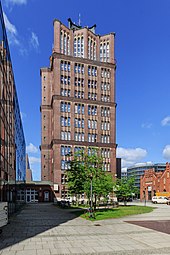Eugen Schmohl
Eugen Schmohl (born August 2, 1880 in Ludwigsburg , † June 18, 1926 in Berlin ; full name: Eugen Georg Schmohl ) was a German architect and university professor .
Life
Schmohl was born in 1880 as the son of the then Ludwigsburg master builder, studied architecture at the Technical University of Stuttgart and worked in Berlin after 1900, initially as an employee in the architecture firm Hart & Lesser and from 1902 to 1907 in Alfred Messel's studio . He then worked as a freelancer, at times also in collaboration with the architect Alfred Salinger . In February 1922 Schmohl was appointed successor to FO Kuhn as a professor at the architecture department of the Technical University Berlin and in January 1926 elected a member of the Prussian Academy of the Arts .
plant
- 1907–1908: Extension of the V. Manheimer clothing store for Ferdinand Manheimer, the son of the company's founder Valentin Manheimer , in Berlin-Mitte , Jägerstraße 33 (with Alfred Salinger, under monument protection )
- 1907–1908: Office and commercial building Mohrenstrasse 54/55 in Berlin-Mitte (with Alfred Salinger, destroyed)
- 1908–1909: residential and commercial building at Krausenstraße 9/10 in Berlin-Mitte (with Alfred Salinger, under monument protection)
- 1909–1913: Borsig Villa Reiherwerder near (Berlin-) Tegel for Ernst von Borsig junior (with Alfred Salinger)
- 1910–1911: Kreisstandsehaus in Saarbrücken , Schlossplatz 16 (with Alfred Salinger, under monument protection)
- 1912–1913: Wertheim department store on Moritzplatz in Berlin-Kreuzberg (destroyed)
- 1913: Kartzow Castle (Gilka country house in Kartzow) near Potsdam
- 1914: Grave monument for Alfred Messel
- 1919–1920: Estate for Ernst von Borsig in Groß Behnitz
- 1919–1920: Reconstruction of the church in Groß Behnitz
- 1922–1925: Borsig AG administrative high-rise (so-called “Borsigturm”) in Berlin-Tegel, Am Borsigturm
- 1923–1925: District Office in Belzig , Niemöllerstrasse (under monument protection)
- 1925: Regimental monument 1914–1918 for the Queen Elisabeth Guard Grenadier Regiment No. 3 in Lietzenseepark in Berlin (with a bronze statue based on a model by the sculptor Wilhelm Gerstel )
- 1925–1927: Ullstein printing house in Berlin-Tempelhof, Mariendorfer Damm
- 1926: Ornamental fountain for the GeSoLei in Düsseldorf (with a sculpture based on a model by the sculptor Wilhelm Gerstel)
The original was later set up in the rose garden of Bochum's city park , a copy for Breitscheidplatz in Cottbus was made in 1929. - 1926–1927: Extension for the Wertheim department store on Leipziger Platz in Berlin, Leipziger Platz 13 (sculptural architectural decorations by sculptor Wilhelm Gerstel, among others; destroyed)
- 1926–1927: Apartment block for the housing association "Heimat" in Berlin-Prenzlauer Berg
literature
- German construction newspaper . 60th year 1926, No. 57 (from July 17, 1926), p. 472. (Obituary)
- Schmohl, Eugen . In: Hans Vollmer (Hrsg.): General lexicon of fine artists from antiquity to the present . Founded by Ulrich Thieme and Felix Becker . tape 30 : Scheffel – Siemerding . EA Seemann, Leipzig 1936, p. 178 .
Individual evidence
- ↑ Personal News . In: Albert Hofmann (Ed.): Deutsche Bauzeitung . Volume 56, No. 15 . Berlin February 22, 1922 ( Textarchiv - Internet Archive ).
- ↑ Kathrin Chod, Herbert Schwenk, Hainer Weisspflug: Manheimer clothing store . In: Hans-Jürgen Mende , Kurt Wernicke (ed.): Berliner Bezirkslexikon, Mitte . Luisenstadt educational association . Haude and Spener / Edition Luisenstadt, Berlin 2003, ISBN 3-89542-111-1 ( luise-berlin.de - as of October 7, 2009).
- ↑ Manheimer clothing store in the monument database of the Berlin Senate Department for Urban Development
- ↑ Berlin architecture world. 11th year 1908/1909, issue 4 (from July 1908), pp. 141–143 (illustrations, floor plans).
- ↑ Commercial building Krausenstrasse 9/10 in the monument database of the Berlin Senate Department for Urban Development
- ^ Nicola Moufang, Hans Thoma: The Grand Ducal Majolica Manufactory in Karlsruhe . C. Winter, Heidelberg 1920, p. 62 ( Textarchiv - Internet Archive , Textarchiv - Internet Archive - With a picture of part of the facade on p. 241).
- ^ Hermann Schmitz: The high-rise of the Borsigwerke in Tegel. Built by Eugen Schmohl. In: Decorative Art, illustrated magazine for applied arts , 28th year 1924/1925, half volume 33, pp. 137–143. ( digital-sammlungen.de ).
- ↑ An industrial building from foundation to completion. Bauwelt-Verlag, Berlin 1927 (PDF, cybra.lodz.pl ).
| personal data | |
|---|---|
| SURNAME | Schmohl, Eugen |
| ALTERNATIVE NAMES | Schmohl, Eugen Georg (full name) |
| BRIEF DESCRIPTION | German architect and university professor |
| DATE OF BIRTH | August 2, 1880 |
| PLACE OF BIRTH | Ludwigsburg |
| DATE OF DEATH | June 18, 1926 |
| Place of death | Berlin |


